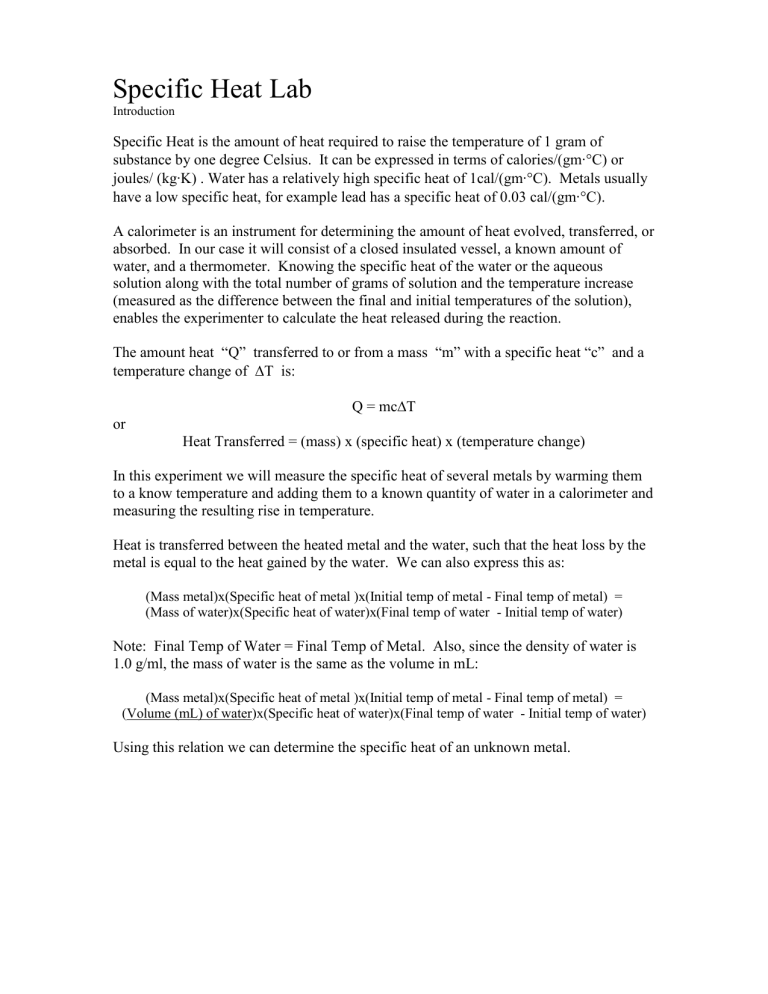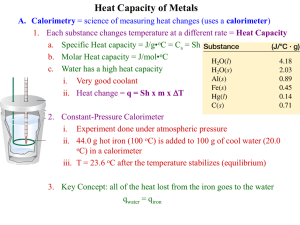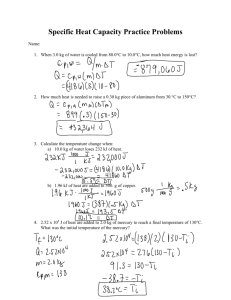Specific Heat Lab.doc

Specific Heat Lab
Introduction
Specific Heat is the amount of heat required to raise the temperature of 1 gram of substance by one degree Celsius. It can be expressed in terms of calories/(gm∙
C) or joules/ (kg∙K) . Water has a relatively high specific heat of 1cal/(gm∙
C). Metals usually have a low specific heat, for example lead has a specific heat of 0.03 cal/(gm∙
C).
A calorimeter is an instrument for determining the amount of heat evolved, transferred, or absorbed. In our case it will consist of a closed insulated vessel, a known amount of water, and a thermometer. Knowing the specific heat of the water or the aqueous solution along with the total number of grams of solution and the temperature increase
(measured as the difference between the final and initial temperatures of the solution), enables the experimenter to calculate the heat released during the reaction.
The amount heat “Q” transferred to or from a mass “m” with a specific heat “c” and a temperature change of
T is:
Q = mc
T or
Heat Transferred = (mass) x (specific heat) x (temperature change)
In this experiment we will measure the specific heat of several metals by warming them to a know temperature and adding them to a known quantity of water in a calorimeter and measuring the resulting rise in temperature.
Heat is transferred between the heated metal and the water, such that the heat loss by the metal is equal to the heat gained by the water. We can also express this as:
(Mass metal)x(Specific heat of metal )x(Initial temp of metal - Final temp of metal) =
(Mass of water)x(Specific heat of water)x(Final temp of water - Initial temp of water)
Note: Final Temp of Water = Final Temp of Metal. Also, since the density of water is
1.0 g/ml, the mass of water is the same as the volume in mL:
(Mass metal)x(Specific heat of metal )x(Initial temp of metal - Final temp of metal) =
(Volume (mL) of water)x(Specific heat of water)x(Final temp of water - Initial temp of water)
Using this relation we can determine the specific heat of an unknown metal.
Specific Heat Lab
Procedure
**NOTE: Use instructions provide by the instructor – DO NOT USE INSTRUCTIONS
IN CHEMLAB! To remove the instructions on the screen, and free-up more working area, perform the following operation: click on the OPTIONS tab; then click on LAB
ONLY. The instructions “disappear” and all of the area is now lab space.**
Step 1: Prepare 3 water baths. Obtain three 250 mL beakers. Add 150mL of water at room temperature to each beaker.
Step 2: Obtain metal sample in test tube. Add three test tubes to the Lab. Select a test tube and add 100 g of Iron Shot (Fe). Add 100 g of Copper Shot (Cu) to the next test tube and 100 g of Aluminum Shot (Al) to the last test tube. Add a thermometer to the test tubes and record the initial temperature of the three metals.
Step 3: Add test tubes with metal to hot water baths. Place a test tube within a beaker
(select both test tube and beaker, and combine from the Arrange Menu
Combine). Now heat the combined beaker test tube arrangement with a bunsen burner. Continue application of heat until the metal shot reaches the boiling point of water (100
C). Heat all three metals (Fe, Cu, Al) at the same time in the three separate water baths.
Step 4: Place heated metal in calorimeter with water at room temp. Add Calorimeter to
Lab (select Equipment menu
Calorimeter). Add 100 mL of water at room temp 20
C to calorimeter. Remove the test tube containing the iron sample from beaker (by selecting beaker and using the Arrange Menu
Remove menu). Pour the heated metal into the calorimeter and close the calorimeter (close calorimeter by selecting calorimeter and pressing the thermometer tool bar button. This will add both a thermometer and a cork top to calorimeter). Record the final temperature of the water (this is also the final temperature of the metal). Repeat Step 4 for Copper and Aluminum.
Specific Heat Lab
Name:__________
Observations
Sect:____________
Data
Note – use initial temperatures as placed in calorimeter.
Initial temperature of metal (ºC)
Final temperature of metal (ºC)
Initial temperature of water from calorimeter (ºC)
Iron
100 ºC
20ºC
Final water temperature from calorimeter (ºC)
Copper Aluminum
100 ºC 100 ºC
20ºC 20ºC
Calculations
(For questions 1-3 use 1 cal/(gm∙ºC) for water and the relationships shown in the introduction)
1) Calculate the specific heat for iron:
2) Calculate the specific heat for copper:
3) Calculate the specific heat for aluminum:
__________ cal/(gm∙ºC)
__________ cal/(gm∙ºC)
__________ cal/(gm∙ºC)
Questions
1) 5.00 g of octane are burned in a bomb calorimeter containing 2.00 X 10
2
g H
2
O.
How much energy, in calories, is released if the water temperature increases
6.00ºC?
__________ calories
2) What is the energy released, in Joules, in Question 1. (1 calorie = 4.18 joules)
__________ joules
3) Calculate the value, in kilojoules, in Question 1.
Discussion
_______kilojoules





